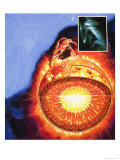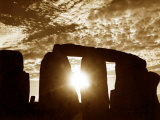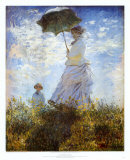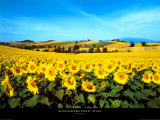|
|
The Sun & Solar System Educational Astronomy Posters
for the science and social studies classrooms, and home schoolers.
|
science > astronomy > THE SUN & SOLAR SYSTEM < seasons
|
|
The Sun is a star in hydrostatic balance at the center of a system of orbiting planets, asteroids, meteoroids, comets and dust located in the Milky Way Galaxy of the Universe. The Sun, also known as Sol, generates its energy through nuclear fusion of hydrogen nuclei into helium.
Our Solar System consists of a center star, our Sun, and nine planets that orbit it. Our Earth is one of the planets. We are held in position by the incredible gravity of the Sun. All these planets orbit the sun in circular paths of the same direction. There are also other smaller objects such as asteroids, comets, moons, meteorites and dust which circle the Sun as the planets do. All these objects and their orbit paths form our solar system, which as a whole orbits the dentere of our galaxy.
1 Sun + 8 Planets + 1 Dwarf (Pluto) + 57 Moons + 10,000 Asteroids + 100 Billion Comets
• “Everything has a natural explanation. The moon is not a god but a great rock and the sun a hot rock.” Anaxagorus
• “Finally we shall place the Sun himself at the center of the Universe. All this is suggested by the systematic procession of events and the harmony of the whole Universe, if only we face the facts, as they say, ‘with both eyes open.’” ~ Copernicus
• “Some painters transform the sun into a yellow spot, others transform a yellow spot into the sun.” Pablo Picasso
• “What happens to a dream deferred? Does it dry up Like a raisin in the sun?... Or does it explode?” Langston Hughes
• “I can find in my undergraduate classes, bright students who do not know that the stars rise and set at night, or even that the Sun is a star.” Carl Sagan
• “The use of solar energy has not been opened up because the oil industry does not own the sun.” Ralph Nader
• “It is the artist's business to create sunshine when the sun fails.” ~ Romain Rolland
• “The sunrise never failed us yet.” Celia Thaxter
|
|
|
|
|
|
|
|
|
|
|
|
|
|
|
|
|
|
|
|
|
|
|
|
|
|
|
|
|
Understanding Skin Cancer Anatomical Chart Laminated
Defines skin cancer and provides detailed illustrations of how it develops from sun exposure. Shows and discusses various types of ultraviolet radiation and how each kind penetrates skin layers. Illustrates and shows photos of various types of precancer and cancer. Lists the ABCs of malignant melanoma and provides graph which indicates the rising incidence of skin cancer. Shows how skin naturally works to prevent skin cancer, and illustrates difference between sunscreen and sun block protection.
• health posters
|
|
|
|

Be Sun Smart
Poster
poster no longer available - sorry
|
Be Sun Smart
Poster Text: Tanning IS skin damage. - It doesn't matter if you tan or burn, it is still damage. The effects of the sun on skin are cumulative – they worsen over years. Avoid exposure to ultraviolet rays (UVA or UVB)/ They not only cause sunburn, but photo-aging (wrinkling), brown age spots, and skin cancer.
Protect Yourself from UV Rays -
• Sunglasses - Use sunglasses and hats that shade your face, ears, nose and the back of your neck.
• Sunscreen - Apply sunscreen with an SPF (Sun Protection Factor) of 15 or higher 30 minutes before sun exposure and reapply regularly – especially if swimming or perspiring.
• Shade - Hang out in the shade during the time of day that the sun is the strongest – 10:00 a.m. to 3:00 p.m.
• Protective Clothing - Wear thicker clothin – UV rays can penetrate lightweight fabrics.
• Tanning Alternatives - If you want a tan, trying tanning lotions or spry-on tans. Avoid the “fake bake” of a tanning bed! The UVA rays are actually stronger than those produced by the sun.
More than a million people will be diagnosed this year with skin cancer – 90% caused by sun exposure.
• safety posters
• child development posters
|
|
|
|
|
|
|
Sunflowers (Helianthus annuus) are annual or perennial plants native to the Americas, in the genus Helianthus, family Asteraceae.
Sunflowers have a large flowering head, made up of numerous florets packed closely together on stems that can grow to 9 ft (3 meters) tall. The leaves and buds of young sunflowers do exhibit heliotropism (sun turning), from east to west during the course of a day. Mature flower heads do not.
FYI - Sunflower is the state flower of Kansas.
• flower posters
|
|
|
previous page | top
|
|
I have searched the web for visual, text, and manipulative curriculum support materials - teaching posters, art prints, maps, charts, calendars, books and educational toys featuring famous people, places and events - to help teachers optimize their valuable time and budget.
Browsing the subject areas at NetPosterWorks.com is a learning experience where educators can plan context rich environments while comparing prices, special discounts, framing options and shipping from educational resources.
Thank you for starting your search for inspirational, motivational, and educational posters and learning materials at NetPosterWorks.com. If you need help please contact us.
|
|
|






























